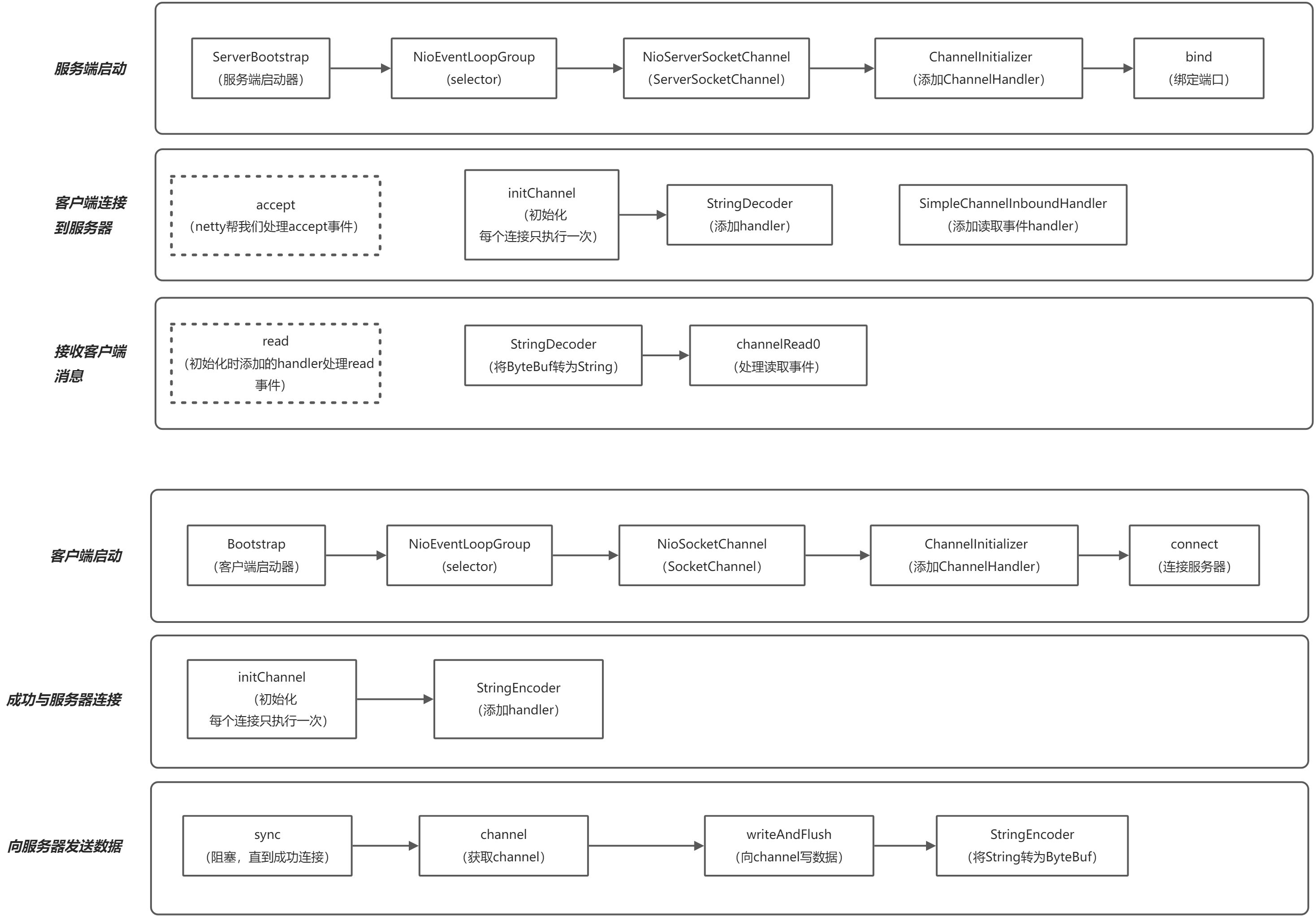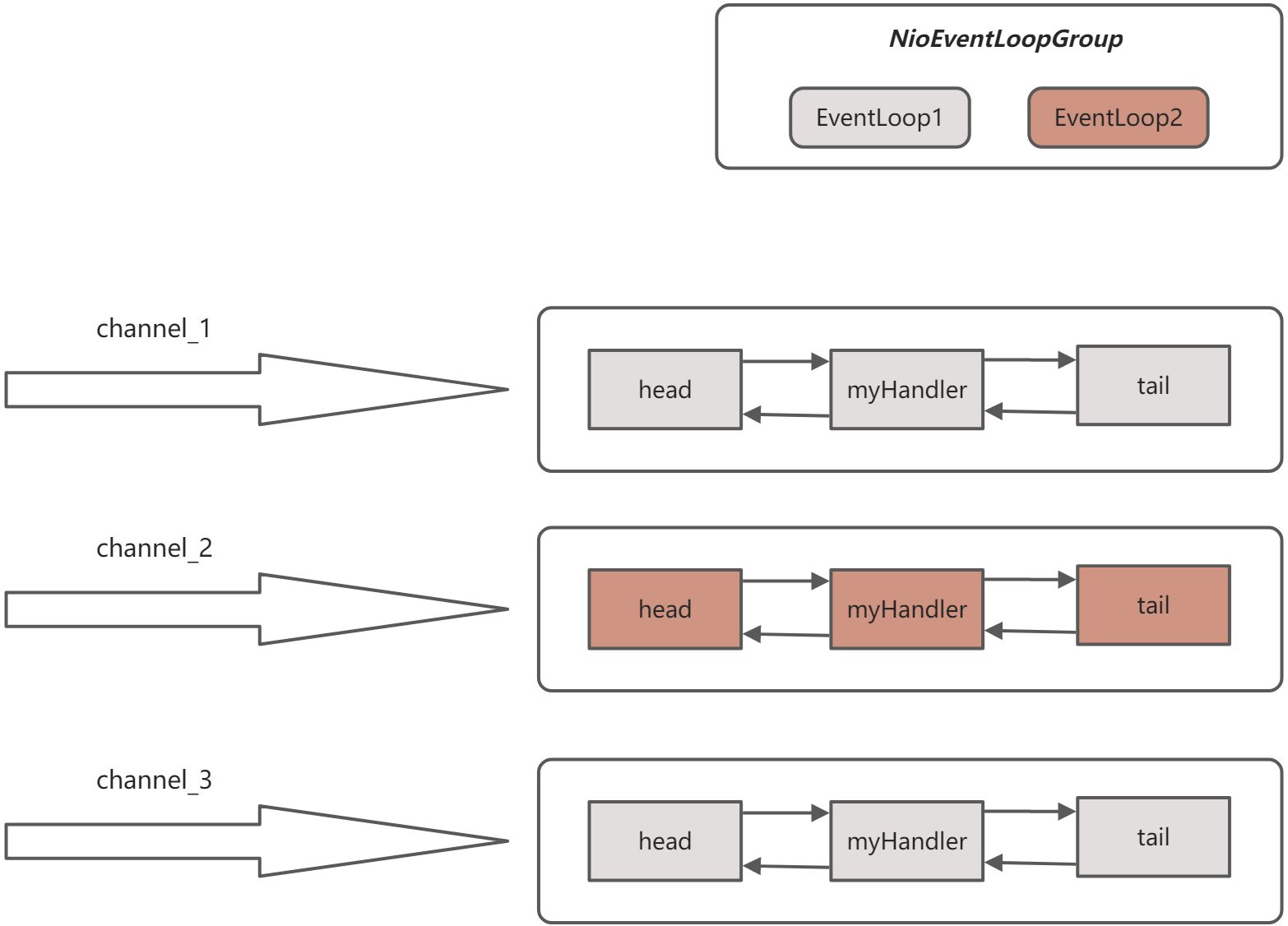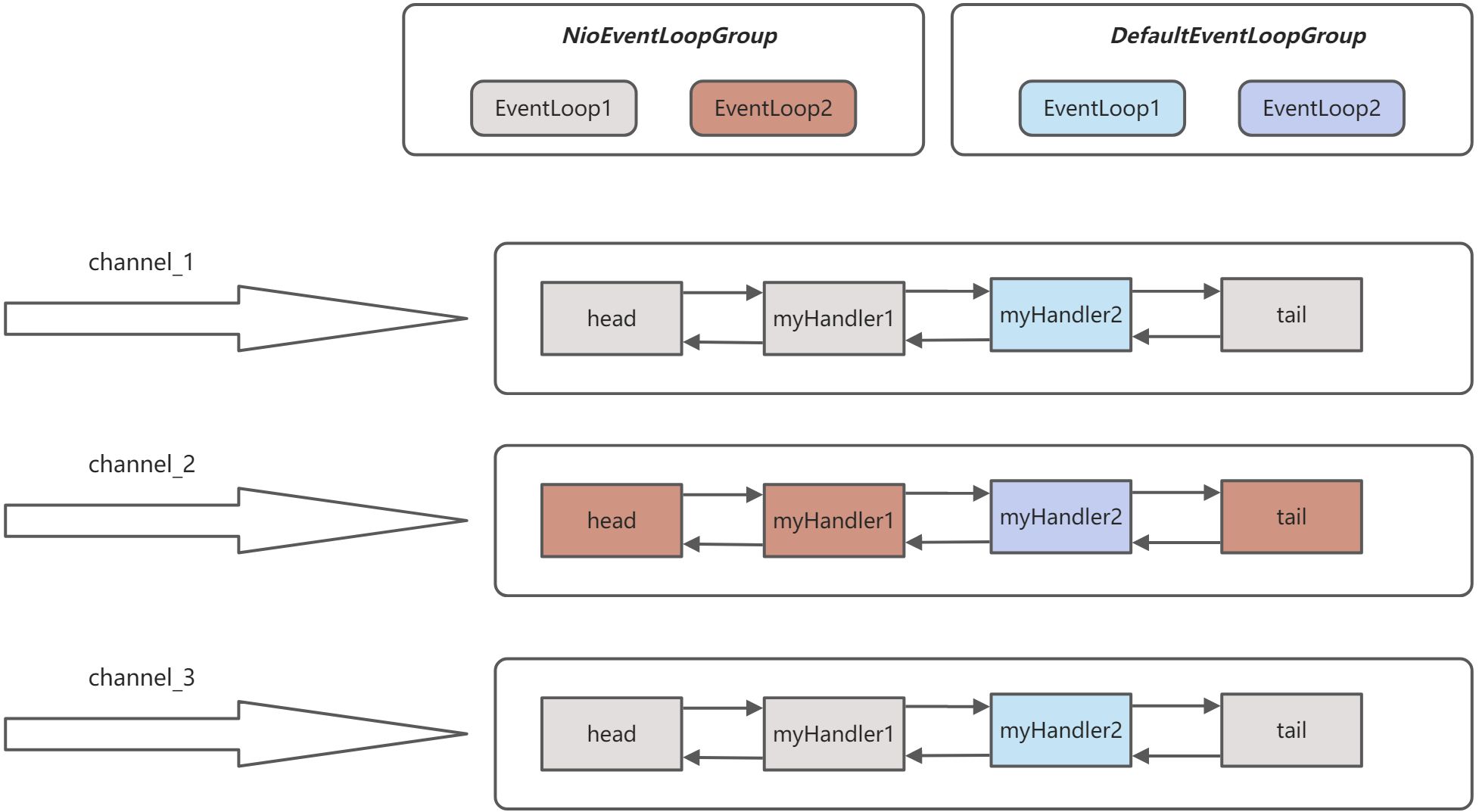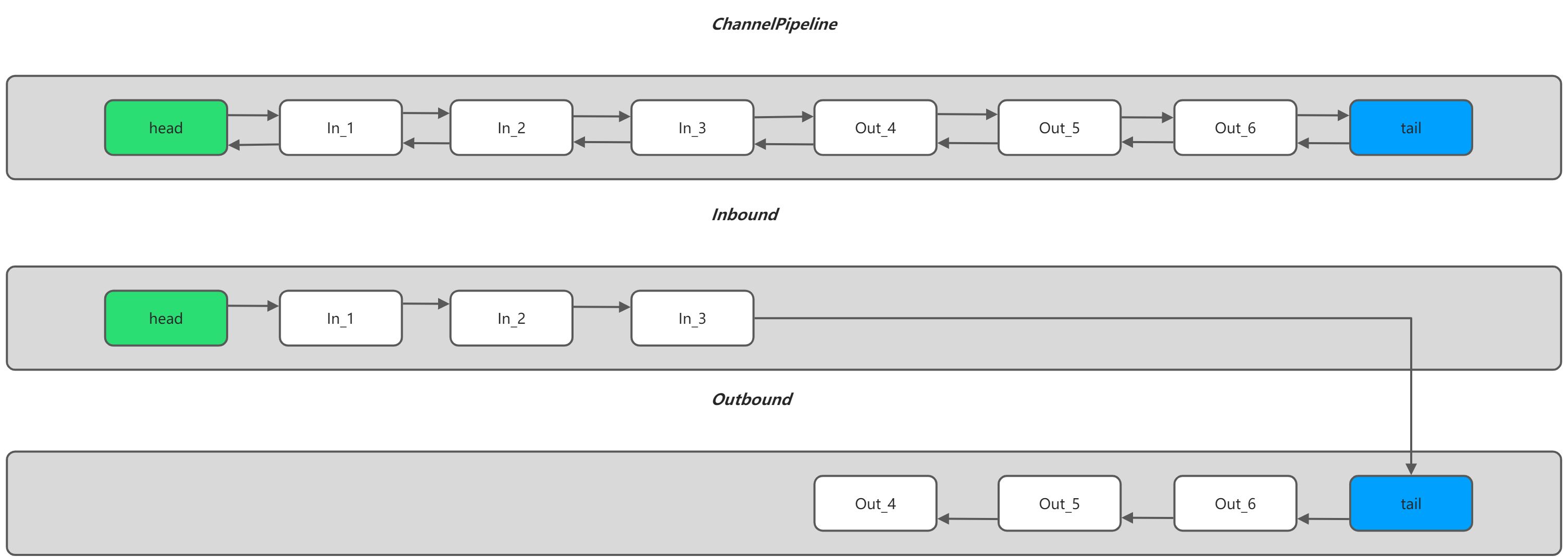 Netty入门
Netty入门
# 概述
Netty 是一个异步的、基于事件驱动的网络应用框架,用于快速开发可维护、高性能的网络服务器和客户端
# Hello World
开发一个简单的服务器端和客户端
- 客户端向服务器端发送 hello, world
- 服务器仅接收,不返回
依赖
<dependency>
<groupId>io.netty</groupId>
<artifactId>netty-all</artifactId>
<version>4.1.39.Final</version>
</dependency>
# 服务端
public static void main(String[] args) {
// 启动器,负责组装 netty 各个组件,启动服务器
new ServerBootstrap()
// group 组,简单理解为 线程池+selector
.group(new NioEventLoopGroup())
// 选择服务器的 ServerSocketChannel 实现,linux、mac 等等,这里选择通用的 nio
.channel(NioServerSocketChannel.class)
// 添加子处理器给 SocketChannel 处理事件,能添加多个
.childHandler(
// channel 代表和客户端进行数据读写的通道
// Initializer 初始化,负责添加其他的handler,在连接建立后会被调用
new ChannelInitializer<NioSocketChannel>() {
@Override
protected void initChannel(NioSocketChannel nioSocketChannel) throws Exception {
// 添加具体的 handler
// 将 ByteBuf 转为 String
nioSocketChannel.pipeline().addLast(new StringDecoder());
// 自定义的 handler
nioSocketChannel.pipeline().addLast(new SimpleChannelInboundHandler<String>() {
// 读事件
@Override
protected void channelRead0(ChannelHandlerContext channelHandlerContext, String msg) throws Exception {
System.out.println(msg);
}
});
}
})
// 绑定监听端口
.bind(8080);
}
# 客户端
public static void main(String[] args) throws InterruptedException {
// 客户端启动器
new Bootstrap()
// selector
.group(new NioEventLoopGroup())
// channel 实现
.channel(NioSocketChannel.class)
// channel 的事件处理
.handler(new ChannelInitializer<NioSocketChannel>() {
@Override
protected void initChannel(NioSocketChannel nioSocketChannel) throws Exception {
// 添加 handler 将 String 转为 ByteBuf
nioSocketChannel.pipeline().addLast(new StringEncoder());
}
})
// 连接地址
.connect("localhost", 8080)
// 同步阻塞,直到成功连接到服务器
.sync()
// 获取与服务器建立的 channel
.channel()
// 向 channel 写数据
.writeAndFlush("hello world");
}
# 执行流程
组装所需的各个组件 添加事件处理器 selector 事件通知对应 handler 进行事件处理
- 如果是 accept,netty 会自动帮我们建立连接,并执行 initChannel 方法
- 如果是 read、write 会调用 initChannel 时添加的 handler 进行处理

举个栗子
- 把 channel 理解为数据的通道
- 把 msg 理解为流动的数据,最开始输入是 ByteBuf,但经过 pipeline 的加工,会变成其它类型对象,最后输出又变成 ByteBuf
- 把 handler 理解为数据的处理工序
- 工序有多道,合在一起就是 pipeline,pipeline 负责发布事件(读、读取完成...)传播给每个 handler, handler 对自己感兴趣的事件进行处理(重写了相应事件处理方法)
- handler 分 Inbound 和 Outbound 两类
- 把 eventLoop 理解为处理数据的工人
- 工人可以管理多个 channel 的 io 操作,并且一旦工人负责了某个 channel,就要负责到底(绑定)
- 工人既可以执行 io 操作,也可以进行任务处理,每位工人有任务队列,队列里可以堆放多个 channel 的待处理任务,任务分为普通任务、定时任务
- 工人按照 pipeline 顺序,依次按照 handler 的规划(代码)处理数据,可以为每道工序指定不同的工人
# 组件
# EventLoop
事件循环对象 EventLoop本质是一个单线程执行器(同时维护了一个Selector),里面有 run 方法处理 Channel 上源源不断的 io 事件。
它的继承关系比较复杂
- 一条线是继承自 j.u.c.ScheduledExecutorService 因此包含了线程池中所有的方法
- 另一条线是继承自 netty 自己的 OrderedEventExecutor,
- 提供了
boolean inEventLoop(Thread thread)方法判断一个线程是否属于此EventLoop - 提供了
parent方法来看看自己属于哪个EventLoopGroup
- 提供了
事件循环组 EventLoopGroup是一组EventLoop,Channel 一般会调用EventLoopGroup的register方法来绑定其中一个EventLoop,后续这个 Channel 上的 io 事件都由此EventLoop来处理(保证了 io 事件处理时的线程安全)
- 继承自 netty 自己的 EventExecutorGroup
- 实现了 Iterable 接口提供遍历 EventLoop 的能力
- 另有 next 方法获取集合中下一个 EventLoop
# 处理普通任务/定时任务
public static void main(String[] args) {
// 可处理 IO 事件,普通任务,定时任务
// 未指定就查看环境变量是否配置了io.netty.eventLoopThreads,否则就是 系统线程数*2,如果都没有就是1
EventLoopGroup group = new NioEventLoopGroup();
// 可处理 普通任务,定时任务
//EventLoopGroup group = new DefaultEventLoop();
// 获取下一个事件循环对象
for (EventExecutor eventExecutor : group) {
System.out.println(eventExecutor);
}
// 执行普通任务
group.next().execute(() -> {
try {
Thread.sleep(1000);
log.info("task");
} catch (InterruptedException e) {
e.printStackTrace();
}
});
// 定时任务
group.next().scheduleAtFixedRate(() -> {
log.info("schedule");
}, 0, 1, TimeUnit.SECONDS);
log.info("main");
// 关闭,并非立即关闭
group.shutdownGracefully();
}
# 优雅关闭
优雅关闭 shutdownGracefully 方法。该方法会首先切换 EventLoopGroup 到关闭状态从而拒绝新的任务的加入,然后在任务队列的任务都处理完成后,停止线程的运行。从而确保整体应用是在正常有序的状态下退出的
# 处理 IO 事件
服务端
public static void main(String[] args) {
new ServerBootstrap()
// 2个 EventLoopGroup
// 参数一的只处理 ServerSocketChannel 的 accept 事件
// 参数二的只处理 SocketChannel 的 read、write事件
.group(new NioEventLoopGroup(), new NioEventLoopGroup(2))
.channel(NioServerSocketChannel.class)
.childHandler(new ChannelInitializer<NioSocketChannel>() {
@Override
protected void initChannel(NioSocketChannel ch) throws Exception {
ch.pipeline().addLast(new ChannelInboundHandlerAdapter() {
@Override
public void channelRead(ChannelHandlerContext ctx, Object msg) throws Exception {
ByteBuf byteBuf = (ByteBuf) msg;
log.info(byteBuf.toString(StandardCharsets.UTF_8));
}
});
}
})
.bind(8080);
}
启动多个客户端发送消息
20:22:48.492 [nioEventLoopGroup-3-1] INFO com.starry.netty.eventloop.EventLoopServer - 111
20:22:58.221 [nioEventLoopGroup-3-2] INFO com.starry.netty.eventloop.EventLoopServer - 222
20:23:08.557 [nioEventLoopGroup-3-1] INFO com.starry.netty.eventloop.EventLoopServer - 333
可以看到两个 EventLoop 轮流处理 channel,并且 EventLoop 与 channel 之间进行了绑定

添加额外 EventLoopGroup
public static void main(String[] args) {
// 新增一个 EventLoopGroup 用来处理事件
DefaultEventLoopGroup group = new DefaultEventLoopGroup(2);
new ServerBootstrap()
// 2个 EventLoopGroup
// 参数一的只处理 ServerSocketChannel 的 accept 事件
// 参数二的只处理 SocketChannel 的 read、write事件
.group(new NioEventLoopGroup(), new NioEventLoopGroup(2))
.channel(NioServerSocketChannel.class)
.childHandler(new ChannelInitializer<NioSocketChannel>() {
@Override
protected void initChannel(NioSocketChannel ch) throws Exception {
ch.pipeline()
.addLast("handler1",new ChannelInboundHandlerAdapter() {
@Override
public void channelRead(ChannelHandlerContext ctx, Object msg) throws Exception {
ByteBuf byteBuf = (ByteBuf) msg;
log.info(byteBuf.toString(StandardCharsets.UTF_8));
// 将消息传递到下一个 handler
ctx.fireChannelRead(msg);
}
})
// 假设事件处理时间较长,可以使用额外 EventLoopGroup 来处理
.addLast(group,"handler2",new ChannelInboundHandlerAdapter(){
@Override
public void channelRead(ChannelHandlerContext ctx, Object msg) throws Exception {
ByteBuf byteBuf = (ByteBuf) msg;
log.info(byteBuf.toString(StandardCharsets.UTF_8));
}
})
;
}
})
.bind(8080);
}
输出
20:54:48.028 [nioEventLoopGroup-4-1] INFO com.starry.netty.eventloop.EventLoopServer - 1
20:54:48.029 [defaultEventLoopGroup-2-1] INFO com.starry.netty.eventloop.EventLoopServer - 1
20:55:18.741 [nioEventLoopGroup-4-2] INFO com.starry.netty.eventloop.EventLoopServer - 2
20:55:18.741 [defaultEventLoopGroup-2-2] INFO com.starry.netty.eventloop.EventLoopServer - 2
20:56:27.911 [nioEventLoopGroup-4-2] INFO com.starry.netty.eventloop.EventLoopServer - 2
20:56:27.912 [defaultEventLoopGroup-2-2] INFO com.starry.netty.eventloop.EventLoopServer - 2
20:57:06.961 [nioEventLoopGroup-4-1] INFO com.starry.netty.eventloop.EventLoopServer - 3
20:57:06.961 [defaultEventLoopGroup-2-1] INFO com.starry.netty.eventloop.EventLoopServer - 3

# handler 执行中如何切换 EventLoop
关键代码io.netty.channel.AbstractChannelHandlerContext#invokeChannelRead()
static void invokeChannelRead(final AbstractChannelHandlerContext next, Object msg) {
final Object m = next.pipeline.touch(ObjectUtil.checkNotNull(msg, "msg"), next);
// 获取下一个 EventExecutor(EventLoop)
EventExecutor executor = next.executor();
// 下一个 EventExecutor 所在线程是否和当前线程相等 return thread == this.thread;
if (executor.inEventLoop()) {
// 相等就直接调用下一个 handler
next.invokeChannelRead(m);
} else {
// 不相等就新建一个线程去调用下一个 handler
executor.execute(new Runnable() {
@Override
public void run() {
next.invokeChannelRead(m);
}
});
}
}
# Channel
channel 的常用方法
close()可以用来关闭 channelcloseFuture()用来处理 channel 的关闭sync方法作用是同步等待 channel 关闭addListener方法是异步等待 channel 关闭
pipeline()方法添加处理器write()方法将数据写入writeAndFlush()方法将数据写入并刷出
# ChannelFuture
public static void main(String[] args) throws InterruptedException, IOException {
ChannelFuture channelFuture = new Bootstrap()
.group(new NioEventLoopGroup())
.channel(NioSocketChannel.class)
.handler(new ChannelInitializer<NioSocketChannel>() {
@Override
protected void initChannel(NioSocketChannel nioSocketChannel) throws Exception {
nioSocketChannel.pipeline().addLast(new StringEncoder());
}
})
// 异步非阻塞,main 线程发起调用,NioEventLoopGroup 真正执行
.connect("localhost", 8080);
Channel channel = channelFuture.channel();
log.info("{}",channel);
// 阻塞,直到成功连接服务器
channelFuture.sync();
channel = channelFuture.channel();
log.info("{}",channel);
}
打印结果
21:42:08.279 [main] INFO com.starry.netty.channel.TestChannel - [id: 0xda02875a]
21:42:08.290 [main] INFO com.starry.netty.channel.TestChannel - [id: 0xda02875a, L:/127.0.0.1:59148 - R:localhost/127.0.0.1:8080]
main 线程执行 第一次还未建立连接,只返回 id 第二次成功建立连接,带有 local 和 remote 信息
还可以使用回调方法
public static void main(String[] args) throws InterruptedException, IOException {
ChannelFuture channelFuture = new Bootstrap()
.group(new NioEventLoopGroup())
.channel(NioSocketChannel.class)
.handler(new ChannelInitializer<NioSocketChannel>() {
@Override
protected void initChannel(NioSocketChannel nioSocketChannel) throws Exception {
nioSocketChannel.pipeline().addLast(new StringEncoder());
}
})
// 异步非阻塞,main 线程发起调用,NioEventLoopGroup 真正执行
.connect("localhost", 8080);
// 异步回调
channelFuture.addListener(new ChannelFutureListener() {
@Override
public void operationComplete(ChannelFuture future) throws Exception {
Channel channel = future.channel();
log.info("{}", channel);
channel.writeAndFlush("hello");
}
});
//Channel channel = channelFuture.channel();
//log.info("{}",channel);
//// 阻塞,直到成功连接服务器
//channelFuture.sync();
//channel = channelFuture.channel();
//log.info("{}",channel);
}
输出
21:48:54.710 [nioEventLoopGroup-2-1] INFO com.starry.netty.channel.TestChannel - [id: 0xdeccec20, L:/127.0.0.1:59352 - R:localhost/127.0.0.1:8080]
nioEventLoopGroup 执行,并不是 main 线程
# CloseFuture
关闭channel并执行后续操作
同步阻塞
public static void main(String[] args) throws InterruptedException, IOException {
NioEventLoopGroup eventLoopGroup = new NioEventLoopGroup();
ChannelFuture channelFuture = new Bootstrap()
.group(eventLoopGroup)
.channel(NioSocketChannel.class)
.handler(new ChannelInitializer<NioSocketChannel>() {
@Override
protected void initChannel(NioSocketChannel nioSocketChannel) throws Exception {
// 日志 handle
nioSocketChannel.pipeline().addLast(new LoggingHandler(LogLevel.DEBUG));
nioSocketChannel.pipeline().addLast(new StringEncoder());
}
})
.connect("localhost", 8080);
Channel channel = channelFuture.sync().channel();
new Thread(() -> {
Scanner scanner = new Scanner(System.in);
while (true) {
String line = scanner.nextLine();
if ("q".equals(line)) {
// 如果输入 q 就关闭 channel
channel.close();
break;
}
channel.writeAndFlush(line);
}
}, "input").start();
ChannelFuture closeFuture = channel.closeFuture();
// 同步阻塞,直到 channel 被关闭
closeFuture.sync();
log.info("do something...");
// 关闭 eventLoopGroup
eventLoopGroup.shutdownGracefully();
}
输出
q
22:10:10.693 [nioEventLoopGroup-2-1] DEBUG io.netty.handler.logging.LoggingHandler - [id: 0x42023d3a, L:/127.0.0.1:59940 - R:localhost/127.0.0.1:8080] CLOSE
22:10:10.693 [main] INFO com.starry.netty.channel.TestCloseFuture - do something...
nioEventLoopGroup 关闭 channel main 处理善后工作
异步回调
public static void main(String[] args) throws InterruptedException, IOException {
NioEventLoopGroup eventLoopGroup = new NioEventLoopGroup();
ChannelFuture channelFuture = new Bootstrap()
.group(eventLoopGroup)
.channel(NioSocketChannel.class)
.handler(new ChannelInitializer<NioSocketChannel>() {
@Override
protected void initChannel(NioSocketChannel nioSocketChannel) throws Exception {
// 日志 handle
nioSocketChannel.pipeline().addLast(new LoggingHandler(LogLevel.DEBUG));
nioSocketChannel.pipeline().addLast(new StringEncoder());
}
})
.connect("localhost", 8080);
Channel channel = channelFuture.sync().channel();
new Thread(() -> {
Scanner scanner = new Scanner(System.in);
while (true) {
String line = scanner.nextLine();
if ("q".equals(line)) {
// 如果输入 q 就关闭 channel
channel.close();
break;
}
channel.writeAndFlush(line);
}
}, "input").start();
ChannelFuture closeFuture = channel.closeFuture();
//// 同步阻塞,直到 channel 被关闭
//closeFuture.sync();
//log.info("do something...");
//// 关闭 eventLoopGroup
//eventLoopGroup.shutdownGracefully();
// 关闭异步回调
closeFuture.addListener((ChannelFutureListener) future -> {
log.info("do something...");
// 关闭 eventLoopGroup
eventLoopGroup.shutdownGracefully();
});
}
输出
q
22:15:01.092 [nioEventLoopGroup-2-1] DEBUG io.netty.handler.logging.LoggingHandler - [id: 0x24f724cd, L:/127.0.0.1:60131 - R:localhost/127.0.0.1:8080] CLOSE
22:15:01.093 [nioEventLoopGroup-2-1] INFO com.starry.netty.channel.TestCloseFuture - do something...
nioEventLoopGroup 进行后续处理,并不是 main 线程
# Future & Promise
在异步处理时,经常用到这两个接口
首先要说明 netty 中的Future与 jdk 中的Future同名,但是是两个接口,netty 的Future继承自 jdk 的Future,而Promise又对netty Future进行了扩展
- jdk Future 只能同步等待任务结束(成功或失败)才能得到结果
- netty Future 可以同步等待任务结束得到结果,也可以异步方式得到结果,但都是要等到任务结束
- netty Promise 不仅有 netty Future 的功能,而且脱离了任务独立存在,只作为两个线程间传递结果的容器
| 功能/名称 | jdk Future | netty Future | Promise |
|---|---|---|---|
| cancel | 取消任务 | - | - |
| isCanceled | 任务是否取消 | - | - |
| isDone | 任务是否完成,不能区分成功失败 | - | - |
| get | 获取任务结果,阻塞等待 | - | - |
| getNow | - | 获取任务结果,非阻塞,还未产生结果时返回 null | - |
| await | - | 等待任务结束,如果任务失败,不会抛异常,而是通过 isSuccess 判断 | - |
| sync | - | 等待任务结束,如果任务失败,抛出异常 | - |
| isSuccess | - | 判断任务是否成功 | - |
| cause | - | 获取失败信息,非阻塞,如果没有失败,返回null | - |
| addLinstener | - | 添加回调,异步接收结果 | - |
| setSuccess | - | - | 设置成功结果 |
| setFailure | - | - | 设置失败结果 |
jdk Future
public static void main(String[] args) throws ExecutionException, InterruptedException {
// 线程池
ThreadPoolExecutor executor = new ThreadPoolExecutor(2, 2, 0L, TimeUnit.SECONDS, new SynchronousQueue<>(), Executors.defaultThreadFactory(), new ThreadPoolExecutor.CallerRunsPolicy());
// 提交任务
Future<Integer> future = executor.submit(new Callable<Integer>() {
@Override
public Integer call() throws Exception {
log.info("calculate...");
Thread.sleep(1000);
return 50;
}
});
// 获取结果
log.info("main thread waiting...");
log.info("result:{}",future.get());
executor.shutdown();
}
netty Future
public static void main(String[] args) throws ExecutionException, InterruptedException {
NioEventLoopGroup group = new NioEventLoopGroup(2);
EventLoop executors = group.next();
Future<Integer> future = executors.submit(new Callable<Integer>() {
@Override
public Integer call() throws Exception {
log.info("calculate...");
Thread.sleep(1000);
return 50;
}
});
log.info("main thread waiting...");
// 同步
//log.info("result:{}",future.get());
// 异步
future.addListener(new GenericFutureListener<Future<? super Integer>>() {
@Override
public void operationComplete(Future<? super Integer> future) throws Exception {
log.info("result:{}",future.getNow());
group.shutdownGracefully();
}
});
}
netty Promise
public static void main(String[] args) throws ExecutionException, InterruptedException {
NioEventLoopGroup group = new NioEventLoopGroup(2);
// 准备 EventLoop 对象
EventLoop executors = group.next();
// 创建 promise 结果容器
Promise<Integer> promise = executors.newPromise();
new Thread(() -> {
// 任意线程执行计算,计算完向 promise 填充结果
log.info("calculate...");
try {
//int i = 1 / 0;
Thread.sleep(1000);
promise.setSuccess(50);
} catch (InterruptedException e) {
e.printStackTrace();
promise.setFailure(e);
}
}).start();
// 获取结果
log.info("main thread waiting...");
log.info("result:{}",promise.get());
group.shutdownGracefully();
}
# Handler & Pipeline
ChannelHandler用来处理Channel上的各种事件,分为入站、出站两种。所有ChannelHandler被连成一串,就是Pipeline
- 入站处理器通常是
ChannelInboundHandlerAdapter的子类,主要用来读取客户端数据,写回结果 - 出站处理器通常是
ChannelOutboundHandlerAdapter的子类,主要对写回结果进行加工
打个比喻,每个Channel是一个产品的加工车间,Pipeline是车间中的流水线,ChannelHandler就是流水线上的各道工序,而后面要讲的ByteBuf是原材料,经过很多工序的加工:先经过一道道入站工序,再经过一道道出站工序最终变成产品
服务端
new ServerBootstrap()
.group(new NioEventLoopGroup())
.channel(NioServerSocketChannel.class)
.childHandler(new ChannelInitializer<NioSocketChannel>() {
protected void initChannel(NioSocketChannel ch) {
ch.pipeline().addLast(new ChannelInboundHandlerAdapter(){
@Override
public void channelRead(ChannelHandlerContext ctx, Object msg) {
System.out.println(1);
ctx.fireChannelRead(msg); // 1
}
});
ch.pipeline().addLast(new ChannelInboundHandlerAdapter(){
@Override
public void channelRead(ChannelHandlerContext ctx, Object msg) {
System.out.println(2);
ctx.fireChannelRead(msg); // 2
}
});
ch.pipeline().addLast(new ChannelInboundHandlerAdapter(){
@Override
public void channelRead(ChannelHandlerContext ctx, Object msg) {
System.out.println(3);
ctx.channel().write(msg); // 3
}
});
ch.pipeline().addLast(new ChannelOutboundHandlerAdapter(){
@Override
public void write(ChannelHandlerContext ctx, Object msg,
ChannelPromise promise) {
System.out.println(4);
ctx.write(msg, promise); // 4
}
});
ch.pipeline().addLast(new ChannelOutboundHandlerAdapter(){
@Override
public void write(ChannelHandlerContext ctx, Object msg,
ChannelPromise promise) {
System.out.println(5);
ctx.write(msg, promise); // 5
}
});
ch.pipeline().addLast(new ChannelOutboundHandlerAdapter(){
@Override
public void write(ChannelHandlerContext ctx, Object msg,
ChannelPromise promise) {
System.out.println(6);
ctx.write(msg, promise); // 6
}
});
}
})
.bind(8080);
客户端
new Bootstrap()
.group(new NioEventLoopGroup())
.channel(NioSocketChannel.class)
.handler(new ChannelInitializer<Channel>() {
@Override
protected void initChannel(Channel ch) {
ch.pipeline().addLast(new StringEncoder());
}
})
.connect("127.0.0.1", 8080)
.addListener((ChannelFutureListener) future -> {
future.channel().writeAndFlush("hello,world");
});
服务端打印
1
2
3
6
5
4
可以看到,ChannelInboundHandlerAdapter是按照addLast的顺序执行的,而ChannelOutboundHandlerAdapter是按照addLast的逆序执行的。ChannelPipeline的实现是一个 ChannelHandlerContext(包装了ChannelHandler) 组成的双向链表
- 入站处理器中,
ctx.fireChannelRead(msg)是 调用下一个入站处理器- 如果注释掉 1 处代码,则仅会打印 1
- 如果注释掉 2 处代码,则仅会打印 1 2
- 3 处的
ctx.channel().write(msg)会 从尾部开始触发 后续出站处理器的执行- 如果注释掉 3 处代码,则仅会打印 1 2 3
- 类似的,出站处理器中,
ctx.write(msg, promise)的调用也会 触发上一个出站处理器- 如果注释掉 6 处代码,则仅会打印 1 2 3 6
ctx.channel().write(msg)vsctx.write(msg)- 都是触发出站处理器的执行
ctx.channel().write(msg)从尾部开始查找出站处理器ctx.write(msg)是从当前节点找上一个出站处理器- 3 处的
ctx.channel().write(msg)如果改为ctx.write(msg)仅会打印 1 2 3,因为节点3 之前没有其它出站处理器了 - 6 处的
ctx.write(msg, promise)如果改为ctx.channel().write(msg)会打印 1 2 3 6 6 6... 因为ctx.channel().write()是从尾部开始查找,结果又是节点6 自己

EmbeddedChannel 对 handler 快速测试
public static void main(String[] args) {
ChannelInboundHandlerAdapter h1 = new ChannelInboundHandlerAdapter() {
@Override
public void channelRead(ChannelHandlerContext ctx, Object msg) throws Exception {
log.info("1");
super.channelRead(ctx, msg);
}
};
ChannelInboundHandlerAdapter h2 = new ChannelInboundHandlerAdapter() {
@Override
public void channelRead(ChannelHandlerContext ctx, Object msg) throws Exception {
log.info("2");
super.channelRead(ctx, msg);
}
};
ChannelOutboundHandlerAdapter h3 = new ChannelOutboundHandlerAdapter() {
@Override
public void write(ChannelHandlerContext ctx, Object msg, ChannelPromise promise) throws Exception {
log.debug("3");
super.write(ctx, msg, promise);
}
};
ChannelOutboundHandlerAdapter h4 = new ChannelOutboundHandlerAdapter() {
@Override
public void write(ChannelHandlerContext ctx, Object msg, ChannelPromise promise) throws Exception {
log.debug("4");
super.write(ctx, msg, promise);
}
};
EmbeddedChannel channel = new EmbeddedChannel(h1, h2, h3, h4);
// 模拟入站操作
//channel.writeInbound(ByteBufAllocator.DEFAULT.buffer().writeBytes("hello".getBytes(StandardCharsets.UTF_8)));
// 模拟出站操作
channel.writeOutbound(ByteBufAllocator.DEFAULT.buffer().writeBytes("world".getBytes(StandardCharsets.UTF_8)));
}
# ByteBuf
是对字节数据的封装
# 创建
ByteBuf buffer = ByteBufAllocator.DEFAULT.buffer(10);
log(buffer);
上面代码创建了一个默认的ByteBuf(池化基于直接内存的 ByteBuf),初始容量是 10
输出
read index:0 write index:0 capacity:10
其中 log 方法参考如下
private static void log(ByteBuf buffer) {
int length = buffer.readableBytes();
int rows = length / 16 + (length % 15 == 0 ? 0 : 1) + 4;
StringBuilder buf = new StringBuilder(rows * 80 * 2)
.append("read index:").append(buffer.readerIndex())
.append(" write index:").append(buffer.writerIndex())
.append(" capacity:").append(buffer.capacity())
.append(NEWLINE);
appendPrettyHexDump(buf, buffer);
System.out.println(buf.toString());
}
# 直接内存 vs 堆内存
可以使用下面的代码来创建池化基于堆的ByteBuf
ByteBuf buffer = ByteBufAllocator.DEFAULT.heapBuffer(10);
也可以使用下面的代码来创建池化基于直接内存的 ByteBuf
ByteBuf buffer = ByteBufAllocator.DEFAULT.directBuffer(10);
- 直接内存创建和销毁的代价昂贵,但读写性能高(少一次内存复制),适合配合池化功能一起用
- 直接内存对 GC 压力小,因为这部分内存不受 JVM 垃圾回收的管理,但也要注意及时主动释放
# 池化 vs 非池化
池化的最大意义在于可以重用ByteBuf,优点有
- 没有池化,则每次都得创建新的
ByteBuf实例,这个操作对直接内存代价昂贵,就算是堆内存,也会增加 GC 压力 - 有了池化,则可以重用池中
ByteBuf实例,并且采用了与jemalloc类似的内存分配算法提升分配效率 - 高并发时,池化功能更节约内存,减少内存溢出的可能
池化功能是否开启,可以通过下面的系统环境变量来设置
-Dio.netty.allocator.type={unpooled|pooled}
- 4.1 以后,非 Android 平台默认启用池化实现,Android 平台启用非池化实现
- 4.1 之前,池化功能还不成熟,默认是非池化实现
# 组成
ByteBuf 由四部分组成
 最开始读写指针都在 0 位置
最开始读写指针都在 0 位置
# 写入
方法列表,省略一些不重要的方法
| 方法签名 | 含义 | 备注 |
|---|---|---|
| writeBoolean(boolean value) | 写入 boolean 值 | 用一字节 01|00 代表 true|false |
| writeByte(int value) | 写入 byte 值 | |
| writeShort(int value) | 写入 short 值 | |
| writeInt(int value) | 写入 int 值 | Big Endian,即 0x250,写入后 00 00 02 50 |
| writeIntLE(int value) | 写入 int 值 | Little Endian,即 0x250,写入后 50 02 00 00 |
| writeLong(long value) | 写入 long 值 | |
| writeChar(int value) | 写入 char 值 | |
| writeFloat(float value) | 写入 float 值 | |
| writeDouble(double value) | 写入 double 值 | |
| writeBytes(ByteBuf src) | 写入 netty 的 ByteBuf | |
| writeBytes(byte[] src) | 写入 byte[] | |
| writeBytes(ByteBuffer src) | 写入 nio 的 ByteBuffer | |
| int writeCharSequence(CharSequence sequence, Charset charset) | 写入字符串 |
注意
- 这些方法的未指明返回值的,其返回值都是
ByteBuf,意味着可以链式调用- 网络传输,默认习惯是
Big Endian
先写入 4 个字节
buffer.writeBytes(new byte[]{1, 2, 3, 4});
log(buffer);
结果是
read index:0 write index:4 capacity:10
+-------------------------------------------------+
| 0 1 2 3 4 5 6 7 8 9 a b c d e f |
+--------+-------------------------------------------------+----------------+
|00000000| 01 02 03 04 |.... |
+--------+-------------------------------------------------+----------------+
再写入一个 int 整数,也是 4 个字节
buffer.writeInt(5);
log(buffer);
结果是
read index:0 write index:8 capacity:10
+-------------------------------------------------+
| 0 1 2 3 4 5 6 7 8 9 a b c d e f |
+--------+-------------------------------------------------+----------------+
|00000000| 01 02 03 04 00 00 00 05 |........ |
+--------+-------------------------------------------------+----------------+
还有一类方法是 set 开头的一系列方法,也可以写入数据,但不会改变写指针位置
# 扩容
再写入一个 int 整数时,容量不够了(初始容量是 10),这时会引发扩容
buffer.writeInt(6);
log(buffer);
扩容规则是
- 如何写入后数据大小未超过 512,则选择下一个 16 的整数倍,例如写入后大小为 12 ,则扩容后
capacity是 16 - 如果写入后数据大小超过 512,则选择下一个 2^n,例如写入后大小为 513,则扩容后
capacity是 210=1024(29=512 已经不够了) - 扩容不能超过
max capacity会报错
结果是
read index:0 write index:12 capacity:16
+-------------------------------------------------+
| 0 1 2 3 4 5 6 7 8 9 a b c d e f |
+--------+-------------------------------------------------+----------------+
|00000000| 01 02 03 04 00 00 00 05 00 00 00 06 |............ |
+--------+-------------------------------------------------+----------------+
# 读取
例如读了 4 次,每次一个字节
System.out.println(buffer.readByte());
System.out.println(buffer.readByte());
System.out.println(buffer.readByte());
System.out.println(buffer.readByte());
log(buffer);
读过的内容,就属于废弃部分了,再读只能读那些尚未读取的部分
1
2
3
4
read index:4 write index:12 capacity:16
+-------------------------------------------------+
| 0 1 2 3 4 5 6 7 8 9 a b c d e f |
+--------+-------------------------------------------------+----------------+
|00000000| 00 00 00 05 00 00 00 06 |........ |
+--------+-------------------------------------------------+----------------+
如果需要重复读取 int 整数 5,怎么办?
可以在read前先做个标记mark
buffer.markReaderIndex();
System.out.println(buffer.readInt());
log(buffer);
结果
5
read index:8 write index:12 capacity:16
+-------------------------------------------------+
| 0 1 2 3 4 5 6 7 8 9 a b c d e f |
+--------+-------------------------------------------------+----------------+
|00000000| 00 00 00 06 |.... |
+--------+-------------------------------------------------+----------------+
这时要重复读取的话,重置到标记位置reset
buffer.resetReaderIndex();
log(buffer);
这时
read index:4 write index:12 capacity:16
+-------------------------------------------------+
| 0 1 2 3 4 5 6 7 8 9 a b c d e f |
+--------+-------------------------------------------------+----------------+
|00000000| 00 00 00 05 00 00 00 06 |........ |
+--------+-------------------------------------------------+----------------+
还有种办法是采用get开头的一系列方法,这些方法不会改变read index
# retain & release
由于 Netty 中有堆外内存的 ByteBuf 实现,堆外内存最好是手动来释放,而不是等 GC 垃圾回收。
UnpooledHeapByteBuf使用的是 JVM 内存,只需等 GC 回收内存即可UnpooledDirectByteBuf使用的就是直接内存了,需要特殊的方法来回收内存PooledByteBuf和它的子类使用了池化机制,需要更复杂的规则来回收内存
回收内存的源码实现,请关注下面方法的不同实现
protected abstract void deallocate()
Netty 这里采用了引用计数法来控制回收内存,每个ByteBuf都实现了ReferenceCounted接口
- 每个
ByteBuf对象的初始计数为 1 - 调用
release方法计数减 1,如果计数为 0,ByteBuf 内存被回收 - 调用
retain方法计数加 1,表示调用者没用完之前,其它handler即使调用了release也不会造成回收 - 当计数为 0 时,底层内存会被回收,这时即使
ByteBuf对象还在,其各个方法均无法正常使用
 因为
因为pipeline的存在,一般需要将ByteBuf传递给下一个ChannelHandler,如果直接在当前finally中release了,就失去了传递性(当然,如果在这个ChannelHandler内这个ByteBuf已完成了它的使命,那么便无须再传递)
基本规则是,谁是最后使用者,谁负责 release,详细分析如下
- 起点,对于 NIO 实现来讲,在
io.netty.channel.nio.AbstractNioByteChannel.NioByteUnsafe#read方法中首次创建ByteBuf放入pipeline(line 163 pipeline.fireChannelRead(byteBuf)) - 入站
ByteBuf处理原则- 对原始
ByteBuf不做处理,调用ctx.fireChannelRead(msg)向后传递,这时无须release - 将原始
ByteBuf转换为其它类型的 Java 对象,这时ByteBuf就没用了,必须release - 如果不调用
ctx.fireChannelRead(msg)向后传递,那么也必须release - 注意各种异常,如果
ByteBuf没有成功传递到下一个ChannelHandler,必须release - 假设消息一直向后传,那么
TailContext会负责释放未处理消息(原始的ByteBuf)
- 对原始
- 出站
ByteBuf处理原则- 出站消息最终都会转为
ByteBuf输出,一直向前传,由HeadContext flush后release
- 出站消息最终都会转为
- 异常处理原则
- 有时候不清楚
ByteBuf被引用了多少次,但又必须彻底释放,可以循环调用release直到返回true
- 有时候不清楚
TailContext释放未处理消息逻辑
// io.netty.channel.DefaultChannelPipeline#onUnhandledInboundMessage(java.lang.Object)
protected void onUnhandledInboundMessage(Object msg) {
try {
logger.debug(
"Discarded inbound message {} that reached at the tail of the pipeline. " +
"Please check your pipeline configuration.", msg);
} finally {
ReferenceCountUtil.release(msg);
}
}
具体代码
// io.netty.util.ReferenceCountUtil#release(java.lang.Object)
public static boolean release(Object msg) {
if (msg instanceof ReferenceCounted) {
return ((ReferenceCounted) msg).release();
}
return false;
}
# slice
【零拷贝】的体现之一,对原始 ByteBuf 进行切片成多个 ByteBuf,切片后的 ByteBuf 并没有发生内存复制,还是使用原始 ByteBuf 的内存,切片后的 ByteBuf 维护独立的read,write指针
 例,原始 ByteBuf 进行一些初始操作
例,原始 ByteBuf 进行一些初始操作
ByteBuf origin = ByteBufAllocator.DEFAULT.buffer(10);
origin.writeBytes(new byte[]{1, 2, 3, 4});
origin.readByte();
System.out.println(ByteBufUtil.prettyHexDump(origin));
输出
+-------------------------------------------------+
| 0 1 2 3 4 5 6 7 8 9 a b c d e f |
+--------+-------------------------------------------------+----------------+
|00000000| 02 03 04 |... |
+--------+-------------------------------------------------+----------------+
这时调用 slice 进行切片,无参 slice 是从原始 ByteBuf 的read index到write index之间的内容进行切片,切片后的max capacity被固定为这个区间的大小,因此不能追加write
ByteBuf slice = origin.slice();
System.out.println(ByteBufUtil.prettyHexDump(slice));
// slice.writeByte(5); 如果执行,会报 IndexOutOfBoundsException 异常
输出
+-------------------------------------------------+
| 0 1 2 3 4 5 6 7 8 9 a b c d e f |
+--------+-------------------------------------------------+----------------+
|00000000| 02 03 04 |... |
+--------+-------------------------------------------------+----------------+
如果原始 ByteBuf 再次读操作(又读了一个字节)
origin.readByte();
System.out.println(ByteBufUtil.prettyHexDump(origin));
输出
+-------------------------------------------------+
| 0 1 2 3 4 5 6 7 8 9 a b c d e f |
+--------+-------------------------------------------------+----------------+
|00000000| 03 04 |.. |
+--------+-------------------------------------------------+----------------+
这时的 slice 不受影响,因为它有独立的读写指针
System.out.println(ByteBufUtil.prettyHexDump(slice));
输出
+-------------------------------------------------+
| 0 1 2 3 4 5 6 7 8 9 a b c d e f |
+--------+-------------------------------------------------+----------------+
|00000000| 02 03 04 |... |
+--------+-------------------------------------------------+----------------+
如果 slice 的内容发生了更改
slice.setByte(2, 5);
System.out.println(ByteBufUtil.prettyHexDump(slice));
输出
+-------------------------------------------------+
| 0 1 2 3 4 5 6 7 8 9 a b c d e f |
+--------+-------------------------------------------------+----------------+
|00000000| 02 03 05 |... |
+--------+-------------------------------------------------+----------------+
这时,原始 ByteBuf 也会受影响,因为底层都是同一块内存
System.out.println(ByteBufUtil.prettyHexDump(origin));
输出
+-------------------------------------------------+
| 0 1 2 3 4 5 6 7 8 9 a b c d e f |
+--------+-------------------------------------------------+----------------+
|00000000| 03 05 |.. |
+--------+-------------------------------------------------+----------------+
# duplicate
【零拷贝】的体现之一,就好比截取了原始 ByteBuf 所有内容,并且没有max capacity的限制,也是与原始 ByteBuf 使用同一块底层内存,只是读写指针是独立的

# copy
会将底层内存数据进行深拷贝,因此无论读写,都与原始 ByteBuf 无关
# CompositeByteBuf
【零拷贝】的体现之一,可以将多个 ByteBuf 合并为一个逻辑上的 ByteBuf,避免拷贝
有两个 ByteBuf 如下
ByteBuf buf1 = ByteBufAllocator.DEFAULT.buffer(5);
buf1.writeBytes(new byte[]{1, 2, 3, 4, 5});
ByteBuf buf2 = ByteBufAllocator.DEFAULT.buffer(5);
buf2.writeBytes(new byte[]{6, 7, 8, 9, 10});
System.out.println(ByteBufUtil.prettyHexDump(buf1));
System.out.println(ByteBufUtil.prettyHexDump(buf2));
输出
+-------------------------------------------------+
| 0 1 2 3 4 5 6 7 8 9 a b c d e f |
+--------+-------------------------------------------------+----------------+
|00000000| 01 02 03 04 05 |..... |
+--------+-------------------------------------------------+----------------+
+-------------------------------------------------+
| 0 1 2 3 4 5 6 7 8 9 a b c d e f |
+--------+-------------------------------------------------+----------------+
|00000000| 06 07 08 09 0a |..... |
+--------+-------------------------------------------------+----------------+
现在需要一个新的 ByteBuf,内容来自于刚才的 buf1 和 buf2,如何实现?
方法1:
ByteBuf buf3 = ByteBufAllocator.DEFAULT.buffer(buf1.readableBytes()+buf2.readableBytes());
buf3.writeBytes(buf1);
buf3.writeBytes(buf2);
System.out.println(ByteBufUtil.prettyHexDump(buf3));
结果
+-------------------------------------------------+
| 0 1 2 3 4 5 6 7 8 9 a b c d e f |
+--------+-------------------------------------------------+----------------+
|00000000| 01 02 03 04 05 06 07 08 09 0a |.......... |
+--------+-------------------------------------------------+----------------+
这种方法好不好?回答是不太好,因为进行了数据的内存复制操作
方法2:
CompositeByteBuf buf3 = ByteBufAllocator.DEFAULT.compositeBuffer();
// true 表示增加新的 ByteBuf 自动递增 write index, 否则 write index 会始终为 0
buf3.addComponents(true, buf1, buf2);
结果是一样的
+-------------------------------------------------+
| 0 1 2 3 4 5 6 7 8 9 a b c d e f |
+--------+-------------------------------------------------+----------------+
|00000000| 01 02 03 04 05 06 07 08 09 0a |.......... |
+--------+-------------------------------------------------+----------------+
CompositeByteBuf是一个组合的ByteBuf,它内部维护了一个Component数组,每个Component管理一个ByteBuf,记录了这个ByteBuf相对于整体偏移量等信息,代表着整体中某一段的数据。
- 优点,对外是一个虚拟视图,组合这些 ByteBuf 不会产生内存复制
- 缺点,复杂了很多,多次操作会带来性能的损耗
# Unpooled
Unpooled 是一个工具类,类如其名,提供了非池化的 ByteBuf 创建、组合、复制等操作
这里仅介绍其跟【零拷贝】相关的wrappedBuffer方法,可以用来包装 ByteBuf
ByteBuf buf1 = ByteBufAllocator.DEFAULT.buffer(5);
buf1.writeBytes(new byte[]{1, 2, 3, 4, 5});
ByteBuf buf2 = ByteBufAllocator.DEFAULT.buffer(5);
buf2.writeBytes(new byte[]{6, 7, 8, 9, 10});
// 当包装 ByteBuf 个数超过一个时, 底层使用了 CompositeByteBuf
ByteBuf buf3 = Unpooled.wrappedBuffer(buf1, buf2);
System.out.println(ByteBufUtil.prettyHexDump(buf3));
输出
+-------------------------------------------------+
| 0 1 2 3 4 5 6 7 8 9 a b c d e f |
+--------+-------------------------------------------------+----------------+
|00000000| 01 02 03 04 05 06 07 08 09 0a |.......... |
+--------+-------------------------------------------------+----------------+
也可以用来包装普通字节数组,底层也不会有拷贝操作
ByteBuf buf4 = Unpooled.wrappedBuffer(new byte[]{1, 2, 3}, new byte[]{4, 5, 6});
System.out.println(buf4.getClass());
System.out.println(ByteBufUtil.prettyHexDump(buf4));
输出
class io.netty.buffer.CompositeByteBuf
+-------------------------------------------------+
| 0 1 2 3 4 5 6 7 8 9 a b c d e f |
+--------+-------------------------------------------------+----------------+
|00000000| 01 02 03 04 05 06 |...... |
+--------+-------------------------------------------------+----------------+
# ByteBuf 优势
- 池化 - 可以重用池中 ByteBuf 实例,更节约内存,减少内存溢出的可能
- 读写指针分离,不需要像 ByteBuffer 一样切换读写模式
- 可以自动扩容
- 支持链式调用,使用更流畅
- 很多地方体现零拷贝,例如 slice、duplicate、CompositeByteBuf
